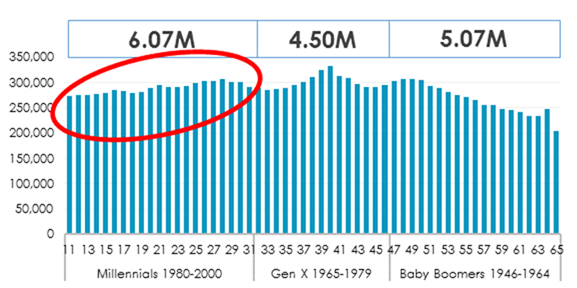The Millennials. The Gen Ys. Generation Me Me Me. I am a Millennial. We are the generation born between 1980 and 2000. We are now the largest generation in the workforce and the most educated generation in Western history. We are technology savvy and are what some researchers have labelled ‘digital natives in a land of digital immigrants’. We have also been described as lazy, narcissistic, nomadic and even a bit delusional.
Whatever stereotypes there are about the Millennials, we are the next consumer market – and there are a lot of us. The time has now come for this generation to move into their prime spending years, but according to the statistics, we are set to reshape the market and challenge the traditional buying and selling models. In fact, some of these trends are already occurring around us including the emergence of a sharing economy, moving away from the traditional ownership style.
Australia is not alone in facing this meta-trend. A recent Goldman Sachs study showed that in the US as at 2015, the breakdown of age across the country skewed:
- Millennials – 92M
- Gen X – 61M
- Baby Boomers – 77M
So let’s quickly have a look at the raw statistics for our country. In Australia at the 2011 Census, the breakdown showed a trend towards a significant number of Millennials entering their prime spending years.
Australia, albeit smaller to US statistics, showed a similar trend (statistics show Census 2011 data):
The then 11-31 year olds are now 16-36 years of age and represented heavily in the Australian workforce. In fact, millennials are now the largest generation in the Australian workforce (by participation), with a significant number still to enter. Working = earning, earning = consuming, consuming = spending in venues and we need to understand them. Let’s have a look at what defines this generation and what this means for our hospitality industry in the coming years.
So what do we know about these 6 million Millennials, our next consumer market?
We know they are technologically aware; they have grown up in a digital world with constant information at their fingertips. We know they are social and have a persistent ‘need to be connected’. Statistics show Millennials have higher levels of debt as a result of increased student loans, but their priorities are also changing, resulting in reduced spending habits for items such as cars, mortgages and luxury goods.
Goldman and Sachs research shows us that the percentage of adults aged 18-31 who are married and living in their own household has dropped from over 55% in 1968 to just over 20% in 2012. Marriage and parenthood seems to be a life stage that ‘can wait’, with median marriage ages in Australia rising from 25 in 1990 to 30 in 2012. This is also consistent with parenthood, with the peak percentage of women having children following a similar trend. That’s not to say this generation is opposed to marriage and children, rather the trend seems to be this stage is occurring later in life.
What about ownership? In Australia more people are renting than ever before. In 1995 the percentage of people renting was 18%, and 2012 statistics show this figure has risen up to 25%. But it isn’t just homes. We have seen a reluctance in the Millennials to purchase such things as cars, music, streaming services and luxury goods, instead turning to services that provide access to these products without the burdens of ownership.
Wellbeing is top on the priority list for Millennials. Unlike previous generations, Millennials define being healthy as eating the right foods and regular exercise, while other generations classify healthy as not falling sick and the correct weight to height ratio. Given the rise in technology, Millennials are now using apps to track training data (excuse me while I sync my Fitbit) and online information to research healthy food options.
So what does this mean for our industry? Here are three starting points to move with the next generation of spenders:
- Make it healthy
We are a generation of wellness and devote time and money to exercising and eating right. These active lifestyles also influence trends from fashion and of course to food and drink. So a key to appealing to the next consumer market is a strong focus on high quality, healthy food. I often use the term ‘Instagram worthy’. One question to ask of your healthy meals may be do they present so nicely and taste so great that someone would actively share them on their food blog or Instagram page?
- Keep it social
We are connected, we are social, we love to share experiences. It is not enough to just have a Facebook page that remains largely as an ‘about me’. Having a digital media strategy is so important in connecting with the Millennial generation. Being active on social media and having a detailed digital media strategy is half the battle. The next stage is to provide an environment that builds ‘shareable’ behaviour. In keeping with our Instagram worthy theme, do your bartenders provide style and class to their craft so that patrons want to share their experience in a single photo? Find the quality in your venue and push the standards to the highest level to become Instagram worthy.
- Make sure your technology works – otherwise we won’t come back
Millennials have grown up with technology and we have come to expect technology for our communication, entertainment, shopping, mapping and education. The affinity for technology helps how we shop, so much so that we now expect instant access to price comparisons, product information and peer reviews. For that reason, we can be your best or worst advocate and to an extent this reduces our loyalty to brands, businesses and venues. Implementing technology into your business is now common practice, and our industry has seen rapid improvements with our process and how we communicate to members and guests. However, get it wrong with complicated interfaces, downtime, consistent errors and the next generation will be ruthless.
These are a small taste of some of the trends we Millennials are showing, making for a very exciting, competitive and challenging future economy that will change the way our businesses appeal to our next consumer market. For our hospitality industry, the three starting points to move with the next generation of spenders should be on your mind: make it healthy, keep it social, and make sure your technology works – otherwise we won’t come back.
Interested in discussing how these trends will influence your venue? Contact us on 07 3878 9355 or info@dws.net.au.




